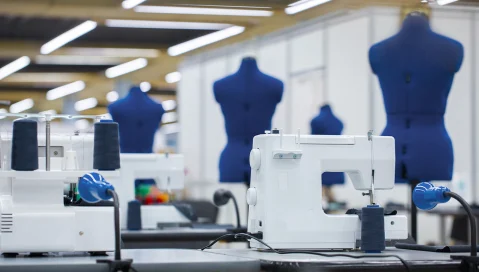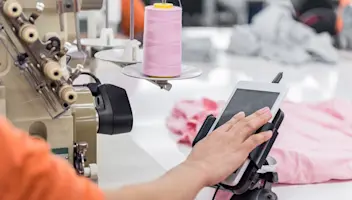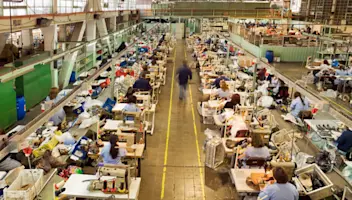How Real-Time Manufacturing Elevates Shop Floor Operations
How Real-Time Manufacturing Elevates Shop Floor Operations
How Real-Time Manufacturing Elevates Shop Floor Operations
11 Nov 2019
Aptean Staff Writer
The overwhelming majority of apparel and soft goods brands lack real-time visibility into production operations. Even companies that benefit from the streamlined automation of a real-time ERP system might see that automation end at the shop floor, if they don’t also utilize a real-time, integrated Shop Floor Control MES solution.
Many brands use third-party manufacturing (3PM), and in the past, contractors may have been reluctant to make the investment in shop floor automation. However, as Shop Floor Control MES solutions have become more affordable, the return on investment has become very rapid—as little as two to six months. For a much smaller investment of time and resources, brands and their contractors now have the ability to streamline shop floor operations, gain visibility, and improve workforce utilization.
Do You Know Where Your WIP Is?
When brands lack real-time visibility into their manufacturing operations, it is impossible to know when work on an order has started and when it will be completed. That makes is difficult to manage customer expectations and make sure you will deliver on your promises.
Companies without a Shop Floor Control MES solution invest a lot of time and effort into simply tracking what is going on with work in progress (WIP). Many have full-time employees whose only job is to circulate around the shop floor checking on orders and then assembling information on clipboards or in Excel spreadsheets. Brands that use 3PM might even have to send their own employees to production facilities to keep the rest of the organization informed.
Real-time Data Provides Instant Visibility into WIP
Shop Floor Control MES software tracks the progress of production throughout your operation in real time, showing managers and supervisors the current status and location of each job on the shop floor. Not only can easy access to real-time information speed up your sewing operations, it also returns time and bandwidth to your management team, so they can focus on more strategic projects instead of manually tracking WIP.
Whether you have one factory or a dozen, Shop Floor Control MES lets you see everything about production with the click of a button. The data is always accurate and always up to date, whether production takes place inside the building or halfway around the world.
Instead tracking jobs manually using gummed sheets and notebooks, workers scan items as they receive them on the production floor, so supervisors can what job is being done—cutting, sewing, embellishing, inspection, shipping—and who is working on it at any moment in time. On one screen, you can see a visual representation of the location of all WIP throughout the production cycle, order by order.
Shop Floor Control MES Helps Identify Bottlenecks and Improve Results
Shop Floor Control MES makes it easier to spot and correct production bottlenecks. Managers receive notifications issues or problems as they occur. Real-time reporting reveals critical information about quality, employee performance, and production costs.
Over time, the collection of shop floor data enables analysis that yields improvements in productivity, product quality and timeliness of order delivery. Shop Floor Control MES helps highlight areas where equipment or training issues impact productivity or quality.
Better Visibility Lowers Inventory Carrying Costs
Real-time data enables brands to increase their forecasting rate significantly, so they can carry less excess inventory and reduce inventory costs. One customer was able to reduce inventory from over $20 million to below $10 million with Shop Floor Control MES.
Real-time Machine Data Lowers Downtime and Costs
Shop Floor Control MES also helps maximize the value of equipment, through faster response to breakdowns and better preventative maintenance. Consider a routine malfunction such as a broken belt on a sewing machine. Without Shop Floor Control MES, the worker must report the machine to a supervisor who will then call maintenance. A maintenance worker comes to verify the problem, then heads back to the shop to get parts. After returning, maintenance replaces the belt and work can resume.
In contrast, Shop Floor Control MES provides a streamlined, two-step process. As soon as the belt breaks, the Shop Floor Control MES system notifies maintenance via text or email. The message identifies the machine and how it is malfunctioning as well as what operator was assigned. Maintenance shows up much more quickly, with the correct tools and parts. Fewer people were involved and machine downtime was minimized.
With predictive analytics, Shop Floor Control MES determines when a belt will become too worn or needles will need replacing, allowing preventative maintenance to be scheduled during off hours. In this way, companies can reduce downtime by 30% to 50%—saving labor costs in both production and maintenance.
When fashion and soft goods manufacturers switch from more manual shop floor operations to Shop Floor Control automation with real-time data, most experience a very rapid 10-15% improvement in overall productivity. But with time, trends in data also deliver greater long-term gains—in fact, 25-40% improvement in productivity is not unusual with the Shop Floor Control MES system. Moreover, Shop Floor Control MES changes the game for the manufacturing workforce. With functionality that can support the productivity of handicaped employees and deliver valuable incentive pay to all, Shop Floor Control MES puts the opportunity to maximize manufacturing earnings in reach for all manufacturing workers.
Schedule a demo today, or get in touch with our team of MES experts to explore the potential benefits of Shop Floor Control MES for your company.
Related Blogs


Ready to start transforming your shop floor?
We’ve got the specialized MES solutions you need to conquer your fashion industry challenges.






